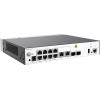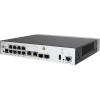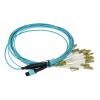-
€




El AC650-256AP de Huawei es un dispositivo que combina un controlador de punto de acceso (WAC) y un switch. Puede gestionar hasta 256 AP al mismo tiempo, por lo que resultará útil en muchos tipos diferentes de redes. Equipado con 10 puertos Gigabit Ethernet (10/100/1000 Mbps) y 2 ranuras SFP+ (10 Gbps), es capaz de gestionar tráfico de 10 Gbps, lo que es importante para redes de gran tamaño. El AC650-256AP tiene un servidor AAA/Portal integrado, que proporciona autenticación a través de portal o 802.1X. Se puede configurar en modo in-path, off-path, bridge o mesh con conexiones de Layer 2 o Layer 3, y admite múltiples conexiones de backup WAC - 1+1 HSB y N+1 backup. El sistema proporciona al administrador amplias herramientas de diagnóstico y detección de fallos. Simplifica y acelera considerablemente la gestión de la red de forma centralizada, por ejemplo configurando rápidamente los puntos de acceso conectados.
Controlador para hasta 256 puntos de acceso
El dispositivo es adecuado como controlador de sistemas inalámbricos Huawei y admite hasta 256 puntos de acceso. Admite el equilibrio de carga mediante itinerancia inteligente, el algoritmo DFA para la detección automática de canales solapados y la programación EDCA y de tiempo de emisión.
El controlador tiene un servidor portal integrado / AAA, y proporciona autenticación de usuario basada en el portal o 802.1X. La autenticación se proporciona para usuarios conectados por cable e inalámbricamente.


Alto rendimiento, 2 ranuras SFP+, 10 puertos Gigabit Ethernet
El AC650-256AP está equipado con 2 ranuras SFP+ de 10 Gbps y 10 puertos Gigabit Ethernet (10/100/1000 Mbps). Dispone de una función de switch integrada, muy útil si se utiliza una configuración in-path.
El dispositivo tiene un potente procesador ARM de cuatro núcleos a 1,2 GHz y 2 GB de RAM DDR4. Es capaz (dependiendo del método de autenticación) de manejar hasta 2.048 usuarios conectados simultáneamente.
Supervisión y diagnóstico avanzados, múltiples opciones de configuración
La interfaz Web ofrece amplias posibilidades de supervisión de la red, comprobando el estado de los usuarios, los puntos de acceso y cada radio. En caso de caída del rendimiento, se dará cuenta muy rápidamente de que un segmento de la red funciona mal. La configuración se simplifica gracias a la posibilidad de crear perfiles y grupos de puntos de acceso. Al conectar un nuevo punto de acceso, se puede copiar la configuración de otro dispositivo. Con un solo clic, puede obtener diagnósticos de red avanzados con opciones sugeridas para solucionar los problemas que se produzcan.
El controlador puede funcionar en distintos modos de red: in-path, off-path, bridge lub mesh. Los puntos de acceso pueden conectarse en Layer 2 o Layer 3, en función de las necesidades del emplazamiento. El AC650-256AP también admite varias funciones de respaldo para garantizar un funcionamiento estable. Puede beneficiarse de la copia de seguridad 1+1 HSB y N+1 WAC y de la copia de seguridad de puertos: LACP (Link Aggregation Control Protocol) o MSP (Multiple Spanning Tree Protocol).


Aplicación
El producto ofertado ha sido diseñado para su uso en grandes redes, donde se requiere una gestión avanzada y una cómoda supervisión del estado de funcionamiento, lo que permite configurar y conectar rápidamente nuevos dispositivos y detectar al instante errores de diversa índole. El uso de un controlador externo también aumenta la estabilidad de toda la red, en el caso del uso de tres dispositivos (controlador + router + conmutador), la carga se distribuye uniformemente entre ellos. Si se utiliza una única puerta de enlace, se puede llegar al punto de que se convierta en el cuello de botella de todo el sistema.
Especificación
| Huawei AC650-256AP | |
| Rendimiento | |
|---|---|
| Número de puntos de acceso gestionados | 256 |
| Número de usuarios |
2048 (el número depende del método de autenticación) |
| Número de direcciones MAC | 8192 |
| Capacidad | 10 Gb/s |
| Número de VLAN | 4096 |
| Número de direcciones IP |
IPv4 4096 IPv6: 2048 |
| Número de entradas ARP | 4096 |
| Número de entradas multicast forward | 2048 |
| Número de grupos de direcciones MAC | 64 grupos de direcciones IP, cada uno de los cuales puede contener un máximo de 8192 direcciones |
| Número de cuentas locales | 1024 |
| Número de ACL | 4096 |
| Propiedades físicas | |
| Dimensiones | 43.6 mm x 210 mm x 250 mm |
| Tipo de interfaces |
2 ranuras SFP+ (10 Gbps) 10 puertos Gigabit Ethernet 1 puerto de consola RJ45 1 puerto USB |
| Consumo máximo | 21 W |
| Peso | 1,47 kg |
| Temperatura de funcionamiento admisible | De 0 a 45 grados C |
| Humedad del aire admisible | 5% - 95% RH no condensante |
| Alimentación | Alimentación externa 12 V / 2 A |
| Características de conmutación | |
| Propiedades de Ethernet |
Ethernet Negociación automática de velocidad, modo dúplex y semidúplex. Rendimiento: 10100/1000 Mbps Control de flujo
VLAN Access / trunk / hybrid Default VLAN VLAN pool
MAC Almacenamiento y borrado automático de direcciones MAC Entradas de direcciones MAC: estáticas, dinámicas, blackhole Filtrado de paquetes basado en la dirección MAC de origen Limitación basada en interfaz de direcciones MAC memorizadas
ARP Entradas ARP estáticas y dinámicas ARP w VLANach Eliminación de entradas ARP
LLDP |
| Ethernet loop protection |
MSTP STP RSTP MSTP Protección BPDU, raíz, antibucle Partitioned STP |
| IPv4 forwarding |
IPv4 ARP i RARP Proxy ARP Detección automática NAT Protocolo Bonjour
Unicast routing Enrutamiento estático RIP-1, RIP-2 OSPF BGP IS-IS Políticas de enrutamiento, enrutamiento basado en políticas URPF check DHCP serwer / relay DHCP Snooping
Multicast routing IGMPv1, IGMPv2, IMPv3 PIM-SM Políticas de enrutamiento multicast RPF |
| IPv6 forwarding |
IPv6 Protocolo ND
Unicast routing Rutas estáticas RIPng OSPFv3 BGP4+ IS_IS IPv6 DHCPv6 DHCPv6 snooping
Multicast routing MLD MLD snooping |
| Estabilidad del dispositivo | BFD |
| Layer 2 multicast |
IGMP Snooping Prompt leave Control del Tráfico Multicast. Replicación de multidifusión entre VLAN |
| Ethernet OAM |
Neighbor discovery Supervisión de la conexión Notificaciones y fallos Remote loopback |
| QoS |
Clasificación del tráfico Clasificación basada en una combinación de cabecera L2, IP de 5 tuplas y prioridad 802.1p
Acciones Control de acceso tras la clasificación del tráfico Políticas de tráfico basadas en la clasificación Remarcación de paquetes basada en la clasificación del tráfico Colas de paquetes basadas en la clasificación Vinculación de los clasificadores de tráfico al comportamiento del tráfico
Horario de colas PQ DRR PQ+DRR WRR PQ+WRR
Evitar la sobrecarga SRED WRED
Control de aplicaciones SAC (Smart Application Control) |
| Configuración y mantenimiento de redes |
Servicios de terminal Configuración mediante la línea de comandos Mensajes de error y ayuda Registro mediante consola y Telnet Envío y comunicación de datos entre usuarios de terminales
Archivos Sistema de archivos Gestión de carpetas y archivos Carga y descarga de archivos FTP y TFTP
Depuración y mantenimiento de la red Gestión unificada de registros, alarmas y depuración Etiquetas Registros de usuario Información detallada de depuración Herramientas de prueba como traceroute y ping Diagnósticos inteligentes Mirroring y flow mirroring
Actualización de la versión Actualización de software en línea Actualización del BIOS en línea In-service patching |
| Gestión de redes |
Diferentes niveles de usuario, protección contra accesos no autorizados SSHv2.0 Autenticación RADIUS y HWTACACS para el inicio de sesión de los usuarios Filtrado ACL Filtrado de paquetes DHCP (con Option 82) Protección contra ataques locales para proteger el procesador Protección contra ataques de paquetes Protección contra ataques: source address spoofing, Land, SYN flood, Smurf, ping flood (ICMP echo), Teardrop, broadcast flood, Ping of Death IPsec Filtrado de URL Antivirus Prevención de intrusiones Ping basado en ICMP, traceroute SNMPv1, SNMPv2c, SNMPv3 MIB RMON NetStream |
| Propiedades inalámbricas | |
| Red entre AP y WAC |
Conexión del AP al WAC a través de una red de Layer 2 o Layer 3 El AP puede conectarse directamente al WAC NAT transversal (AP en red privada, WAC en red pública) El WAC se puede utilizar como Layer 2 bridge o Layer 3 router. El escape de autenticación WAC es soportado entre el AP y el WAC. En modo forwading local, esta función comprueba el estado de los clientes conectados y permite acceder a nuevos clientes cuando el AP se desconecta del WAC |
| Modo forwarding |
Reenvío directo Reenvío por túnel Autenticación central En el modo de reenvío directo, los paquetes de autenticación de usuario admiten el reenvío por túnel Reenvío GRE suave Reenvío por túnel + túnel EoGRE |
| Modos inalámbricos |
WDS bridging Puente inalámbrico PTP (punto a punto) Puente inalámbrico P2MP (punto a multipunto) Detección automática de topología y protección contra bucles (STP) Red inalámbrica Mesh Control de acceso de dispositivos Mesh Algoritmo de enrutamiento Mesh Aprovisionamiento de configuración cero (ZTP) Red Mesh con múltiples MPP Vehicle-ground fast link handover Modo Mesh cliente |
| WAC discovery |
El AP puede obtener la dirección IP del WAC mediante: configuración estática Soporte DHCP / DHCPv6 relay Cuando se utilizan redes de Layer 2, el AP puede detectar el WAC enviando paquetes CAPWAP |
| Túnel CAPWAP |
CAPWAP central Túnel de control CAPWAP y túnel opcional con danei Túnel CAPWAP / reenvío directo Cifrado DTLS, activado por defecto en el túnel de control CAPWAP Detección de Heartbit, reconexión del túnel |
| WAC activo/en espera |
Conmutación on/off Soporta balanceo de carga Soporta 1+1 HSB Admite copia de seguridad N+1 Sincronización de configuración inalámbrica entre WACs Licencia compartida entre WACs |
| Gestión AP | |
| Control de acceso AP |
Muestra la dirección MAC o SN en la lista blanca Añade uno o varios AP (por rango de direcciones MAC / SN) a la lista blanca Detección automática y aceptación manual de APs Detección automática de APs sin confirmación manual |
| Gestión regional AP |
Admite tres formas de colocar los AP Distribuida: los puntos de acceso se colocan de forma independiente. Cada AP se trata como una región y no interfiere con otros AP. En este modo, el AP funciona a máxima potencia y no realiza calibración de radio.
|
| Gestión del perfil AP | Configuración del perfil de AP predeterminado que se asignará automáticamente a los AP descubiertos |
| Gestión de los tipos de AP |
Gestión de atributos de AP como número de interfaces, tipo de AP, número de radios, tipo de radio, número máximo de VAP, número máximo de usuarios o ganancia de radio Tipos de AP predeterminados integrados |
| Gestión de la topología de red | Admite la detección de topología LLDP |
| Gestión del modo AP | Soporta el cambio de modo AP. Los modos se pueden cambiar entre Fat y Cloud desde el WAC. |
| Gestión de la radio | |
| Gestión de perfiles radioeléctricos |
Admite la configuración de los siguientes parámetros modo de radio y ancho de banda Asignación de perfiles a una radio Soporte MU-MIMO |
| Configuración unificada de parámetros estáticos | Configura los parámetros de radio (como el canal y la potencia) desde el WAC y envía la configuración al AP |
| Gestión dinámica |
Los AP pueden seleccionar automáticamente los canales de funcionamiento y ajustar la potencia durante el arranque En una región determinada, los AP ajustan automáticamente el canal operativo y la potencia cuando se detectan interferencias: calibración parcial - ajustes óptimos de canal y potencia de un AP concreto Selección y calibración automática de los parámetros de radio en la región del AP |
| Funciones avanzadas |
Control del ancho de banda: permite la conexión preferente en la banda de 5 GHz y el equilibrio de carga entre las bandas de 2,4 y 5 GHz. Itinerancia inteligente: permite cambiar los terminales a AP con mejor señal
|
| Gestión de servicios WLAN | |
| Gestión ESS |
Habilita la difusión de SSID, la configuración del número máximo de usuarios y la configuración del tiempo de eliminación en el ESS Aísla los AP en Layer 2 en el ESS Mapeo de ESS en VLAN de servicio Asocia ESS con perfiles de seguridad y QoS Habilita IGMP para APs en ESS |
| Gestión de servicios basada en VAP |
Añade varios VAP al asignar una radio a un ESS Muestra información sobre un solo VAP, un VAP con un ESS configurado o todos los VAPs Admite la configuración de AP fuera de línea Crea varios VAP simultáneamente según las reglas de aprovisionamiento en modo de reconocimiento automático de AP |
| Gestión de autoaprovisionamiento |
Admite el aprovisionamiento de reglas de configuración para radios específicas o tipos de AP específicos. Añade AP detectados automáticamente a la región de AP por defecto. La región de AP por defecto se puede cambiar Puede asignar una regla a una región AP que haga que todos los AP de esa región se enciendan |
| Gestión de multidifusión |
IGMP snooping IGMP proxy |
| Load balancing |
Equilibrio de banda entre radios en un grupo de equilibrio de carga Admite dos modos de equilibrio de ancho de banda basado en el número de clientes conectados a la radio |
| BYOD (Bring Your Own Device) |
Identificación del dispositivo según OUI en la dirección MAC Identificación del dispositivo según el campo UA (User Agent) del paquete HTTP Identificación del dispositivo según la información de la opción DHCP Almacenamiento de la información del dispositivo en las cuentas de autenticación y paquetes RADIUS |
| Localización |
Localiza etiquetas AeroScout y Ekahau Localización de terminales Wi-Fi Localización de terminales Bluetooth Localización de etiquetas Bluetooth |
| Análisis del espectro |
Identifica las fuentes de interferencias: Bluetooth, hornos microondas, teléfonos inalámbricos, ZigBee, mandos de juegos, dispositivos de audio y vídeo de 2,4 / 5 GHz, niñeras inalámbricas Funciona con eSight para mostrar las fuentes de interferencias |
| Hotspot 2.0 | Admite la red Hotspot 2.0 |
| Internet of Things (IoT) | Admite tarjetas IoT en el AP para proporcionar cobertura WLAN e IoT |
| Navi WAC | Admite el acceso remoto de clientes en Navi WAC |
| Control central de licencias |
Admite un servidor de licencias que permite la gestión centralizada de las licencias AP Permite que el servidor gestione las licencias de los clientes Admite la sincronización entre el servidor de licencias y los clientes |
| Gestión de usuarios WLAN | |
| Asignación de direcciones de usuario | Funciona como servidor DHCP para asignar direcciones IP a los usuarios inalámbricos |
| Gestión de usuarios WLAN |
Lista blanca y negra Controla el número de usuarios basado en AP mensajes RADIUS DM estado del usuario basado en la dirección MAC del usuario, dirección IP del AP, ID de radio o ID de WLAN |
| Usuarios itinerantes de WLAN |
Intra-AC Layer 2 roaming Inter-VLAN Layer 3 roaming en WAC Roaming entre WACs Fast key negotiation en la autenticación 802.1X Autentica a los usuarios que intentan volver a conectarse al WAC, rechaza las solicitudes de usuarios no autorizados Retrasa la eliminación de la información de usuario después de que un usuario se desconecte para permitir una rápida transición de vuelta al estado en línea. |
| Gestión de grupos de usuarios |
Compatibilidad con listas de acceso (ACL) Aislamiento de usuarios:
|
| Seguridad WLAN | |
| Gestión de perfiles de seguridad WLAN |
Gestión de la autenticación y el cifrado mediante perfiles Asignación de perfiles de seguridad a perfiles ESS |
| Modos de autenticación |
Open system authentication - sin cifrado Cifrado/autenticación WEP Cifrado y autenticación WPA/WPA2:
Cifrado y autenticación WPA/WPA2-PPSK Autenticación y cifrado WAPI Autenticación WAPI centralizada Autenticación a través de portal: Autenticación a través de un portal externo Autenticación mediante servidor 802.1X externo |
| Autenticación combinada |
Autenticación combinada MAC: PSK+MAC Autenticación MAC+Portal: autenticación portal con prioridad de dirección MAC |
| AAA |
Autenticación local / cuentas locales (dirección MAC como cuenta) Autenticación RADIUS Múltiples servidores de autenticación: admite un servidor de autenticación de reserva |
| Aislamiento | Aislamiento basado en puerto o grupo de usuarios |
| WIDS | Exploración, identificación, protección y contención de dispositivos fraudulentos, incluida la configuración de listas negras dinámicas, la detección de puntos de acceso fraudulentos, clientes fraudulentos y ataques a la red |
| Control de autenticación |
Límite ACL basado en: puerto |
| Otros dispositivos de seguridad |
Ocultación de SSID IP source guard Asignación estática de ID y MAC Generación dinámica de conexiones IP y MAC |
| WLAN QoS | |
| Gestión de perfiles WMM |
Activación/desactivación de WMM (Wi-Fi Multimedia) El perfil WMM puede aplicarse a múltiples radios AP |
| Gestión de perfiles de tráfico |
Gestión del tráfico desde los AP y asignación de prioridad a los paquetes según los perfiles de tráfico Aplicación de políticas de QoS a cada ESS mediante la asignación de un perfil de tráfico al ESS |
| Control de movimiento de AC |
Gestión de perfiles QoS ACL se utiliza para clasificar el tráfico Límite de tráfico entrante y saliente para cada usuario basado en parámetros CAR de entrada/salida Límite de tráfico basado en ESS o VAP |
| Control de movimiento de AP |
Controla el tráfico multiusuario, permite compartir el ancho de banda Límite de ancho de banda según VAP |
| Configuración de prioridades de paquetes |
Prioridad QoS (precedencia IP o DSCP) para el canal de control CAPWAP configuración de la prioridad QoS al canal de datos CAPWAP:
|
| Airtime fair scheduling | Los usuarios disponen del mismo tiempo para ocupar los canales, lo que mejora la calidad del acceso a Internet |






 Polski
Polski English
English Italiano
Italiano Español
Español Čeština
Čeština Српски
Српски Deutsch
Deutsch Ελληνικά
Ελληνικά Slovenský
Slovenský





